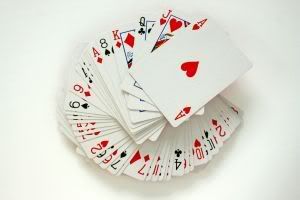It’s a Kind of Magic
 Growing up I was always interested in magic. My Grandfather always had a trick or two with them and would entertain anyone within earshot with it. I collected magic tricks of all sorts and practices fairly regularly on them. I even did a children’s birthday party complete with levitating woman at the end of the show. Eventually I got interested in other things, but I always kept a trick or two in my memory in case the opportunity ever arose. Periodically I check out books from the library on magic tricks and practice a few of them. I still have my old case of magic tricks and the kids become thrilled when I pull it out. There isn’t anything really special in there, just your garden variety tricks, but it still holds wonder for the kids.
Growing up I was always interested in magic. My Grandfather always had a trick or two with them and would entertain anyone within earshot with it. I collected magic tricks of all sorts and practices fairly regularly on them. I even did a children’s birthday party complete with levitating woman at the end of the show. Eventually I got interested in other things, but I always kept a trick or two in my memory in case the opportunity ever arose. Periodically I check out books from the library on magic tricks and practice a few of them. I still have my old case of magic tricks and the kids become thrilled when I pull it out. There isn’t anything really special in there, just your garden variety tricks, but it still holds wonder for the kids.
The last time I “performed” was when I was working on my Masters. In one class our professor encouraged us to do something we had never done during a presentation. I had already incorporated sound and video in previous presentations so I needed something out of the ordinary. My last trip to Las Vegas saw me purchasing a new trick where you can throw a card and have it return to you. You also can make it hover between your fingers, floating there in space.
So, time comes for my presentation and I set up the video camera so I can see how it went later. I started off with a basic card trick and then launched into my presentation about thriving in a corporate environment when you are a creative-type person. I talked about my different points and then added a little magic to emphasize my points. The climax came when I through the card out and held it magically between my hands, still spinning. I was concentrating on doing the trick correctly and keeping up the speech that I barely registered that my classmates actually clapped for me. They were actually that impressed. Watching the video later I saw a pretty polished presentation and was proud of what I did.
Here’s the interesting part, at least to me. When I saw the magic trick with the flying card performed in Las Vegas, I immediately tried to figure out how it was done. The store had a policy that when they sold a trick, they would take you in a secret room and show you how it was done. So I bought it and went in to the room. Imagine my surprise when I discover that the trick had a very simple explanation, something worlds less complex than the scenario I had in my head. It was so basic that I immediately dismissed it.
And that was when I realized the true trick of magic. The solution to a trick is almost always the simplest. This became a true epiphany. It is not smoke and magnets and mirrors, it is practice, misdirection, and practice. Also here a truth that I did not realize revealed itself to me. Even if you know how the trick is done, it is still fun and “magical” to watch it because it is a performance. At a play I attended before the show there was a magician doing close up magic, sleight-of-hand stuff. He was very good and had a good patter to go along with the tricks. He stood less than a foot away from me and I knew how the tricks were being done but I could never see him do the different drops and handoffs that the tricks required. Knowing the secret in no way lessened my enjoyment.
So what does this have to do with finding balance and solving problems? When you come across an issue, often the most effective solution is the most direct. Say a magician wants to walk through a wall. There are quite a few ways he could do it. He could physically cut a hole in the wall, somehow disguise it from the audience, and then walk through it. Doable, but difficult. Or, he could find a double, somehow hide himself as he started to walk through the wall and then have the double appear on the other side. Again doable, but not without its share of problems. Or, he could simply walk around the wall in such a way that the audience never notices him. He could change clothes to look like the assistants he has, walk with them to the other side of the wall and then change clothes again. Now if the assistants were assembling and dissembling some kind of partition, the magician would be able to change clothes and blend in with them. So which method do you think they use?
So apply the basic principle of magic to your next problem. The simplest answer is often the best. It is also often the easiest. Life is complex enough without adding additional difficulty to it.
Posted: September 3rd, 2008 under Decisions.
Comments: none